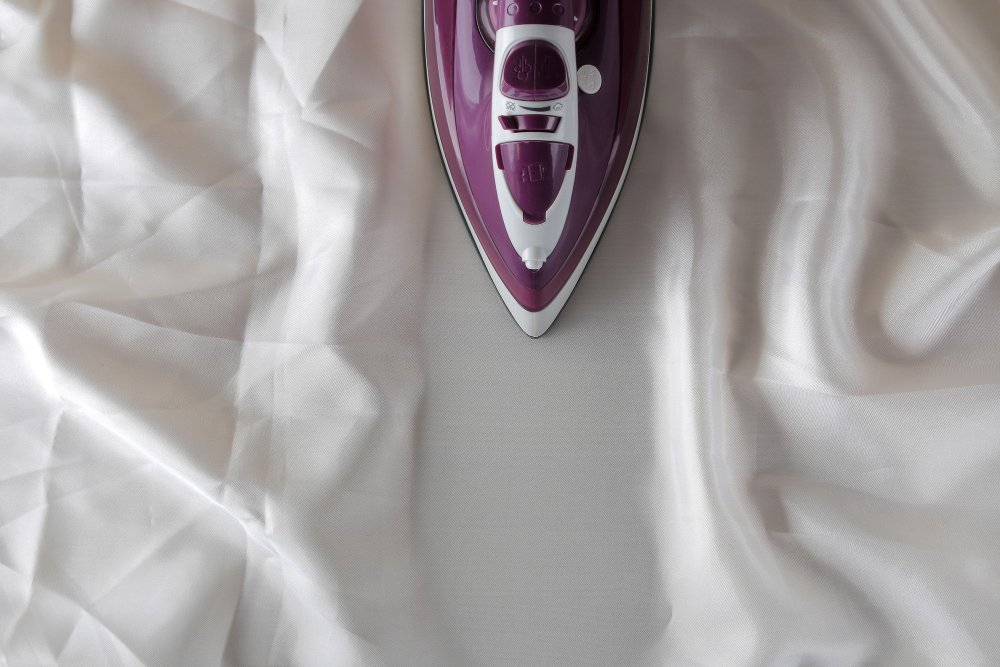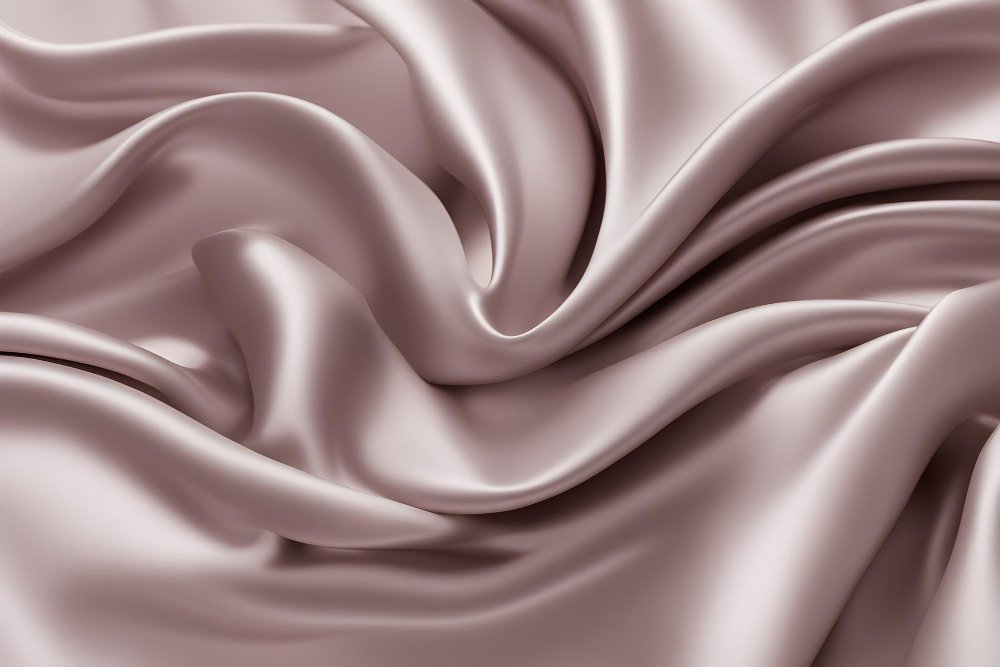Everything You Need to Know About This Affordable, Versatile Alternative to Natural Silk
Table of Contents
- What is Art Silk Fabric?
- The History of Art Silk
- How Art Silk is Made
- Types of Art Silk
- Art Silk vs Real Silk
- Art Silk vs Other Fabrics
- Properties and Characteristics
- Sustainability and Environmental Impact
- Uses and Applications
- Complete Care Guide
- Quality Assessment Guide
- Buying Guide
- Regional Variations
- Future Innovations
- Frequently Asked Questions
- Conclusion
What is Art Silk Fabric?
Art silk, short for artificial silk, is a man-made fabric designed to look and feel like natural silk but at a much lower cost. Think of it as the smart alternative to expensive silk that still gives you that luxurious shine and smooth drape you want.
This fabric is made from synthetic or semi-synthetic fibers like rayon, polyester, or nylon. The name “art silk” is sometimes used interchangeably with rayon or viscose, though technically these are just types of art silk. The main goal? To capture the beauty of silk without the high price tag or ethical concerns about silkworm farming.
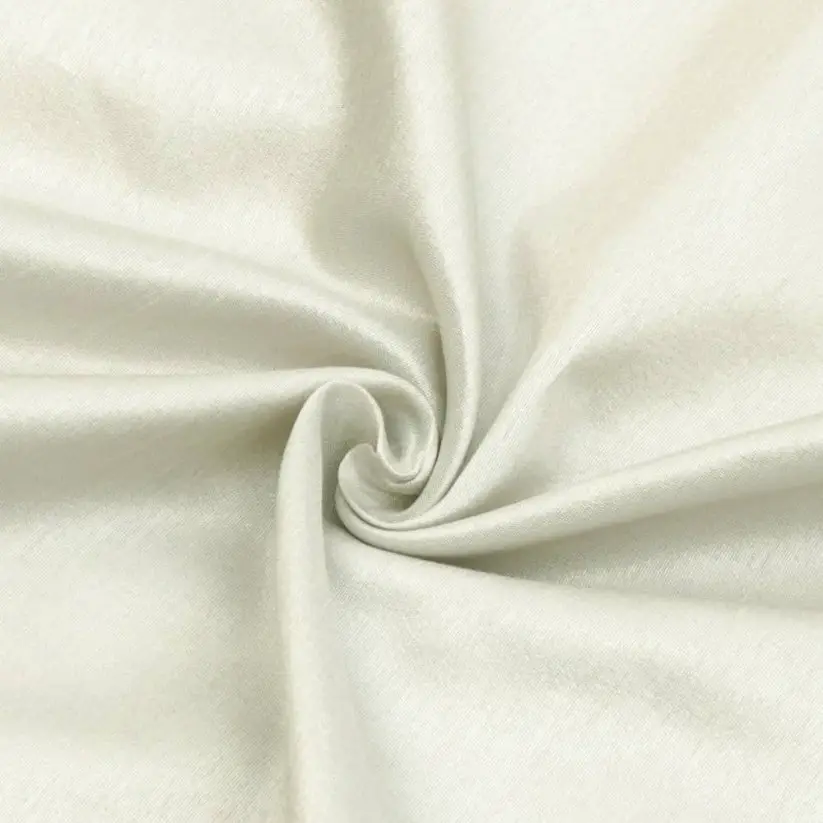
Quick Definition
Art silk is any synthetic or semi-synthetic fiber that mimics the appearance, texture, and drape of natural silk. It’s also known as artificial silk, faux silk, synthetic silk, or simply viscose/rayon in many regions.
Cost
60-80% cheaper than real silk
Main Materials
Rayon, polyester, nylon
Common Uses
Sarees, dresses, scarves, bedding
Care Level
Easier than real silk
The History of Art Silk
The story of art silk is actually pretty interesting. It started in the late 1800s when scientists wanted to create a cheaper alternative to natural silk, which was incredibly expensive and limited in supply.
The first successful art silk was created in France using cellulose fiber. It was marketed as “viscose” or “art silk” and became an instant hit in Europe and the United States.
The name was officially changed to “Rayon” in the United States, though Europeans continued using the term “viscose.” Both names are still used today.
Henry Ford (yes, the car guy!) hired chemists to make artificial silk from soybean fibers. While this didn’t take off commercially, it showed how creative people were getting with silk alternatives.
Nylon was developed in the United States and became a silk replacement during World War II when Japanese silk became unavailable. Nylon was perfect for parachutes and other military uses.
Art silk is made from rayon, polyester, nylon, or blends of these materials. Modern production methods have greatly improved quality, making it hard to tell the difference from real silk at first glance.
How Art Silk is Made
Understanding how art silk is made helps explain why different types have different properties. The manufacturing process varies depending on which type of fiber is being used.
Rayon/Viscose Production
Rayon is actually a semi-synthetic fiber because it starts with natural plant cellulose (usually from wood pulp, bamboo, or beech trees) but goes through heavy chemical processing.
The Rayon Manufacturing Process:
- Cellulose Extraction: Wood pulp or bamboo is broken down to extract cellulose fibers
- Chemical Treatment: The cellulose is soaked in sodium hydroxide (caustic soda) to create “alkali cellulose”
- Aging: The alkali cellulose is aged to break down the molecular chains
- Xanthation: Carbon disulfide is added to create cellulose xanthate
- Dissolving: This is dissolved in sodium hydroxide to create a thick, honey-like liquid called viscose
- Spinning: The viscose is forced through tiny holes (spinnerets) into an acid bath, where it solidifies into fibers
- Washing and Processing: The fibers are washed, bleached, and treated to create the final rayon fabric
Modern variations include Tencel (lyocell) and Modal, which use closed-loop processes that recycle chemicals and are more environmentally friendly.
Polyester Production
Polyester is a fully synthetic fabric made from petroleum-based compounds. When used as art silk, it’s engineered to mimic silk’s appearance.
The Polyester Manufacturing Process:
- Chemical Reaction: Petroleum-based chemicals (ethylene glycol and terephthalic acid) are combined through a process called polymerization
- Creating PET: This creates polyethylene terephthalate (PET), the same material used in plastic bottles
- Melting: The PET is melted at very high temperatures (around 246°C or 475°F)
- Spinning: The melted polymer is forced through spinnerets to create long, smooth fibers
- Cooling: The fibers cool and solidify into strong, durable threads
- Weaving: These threads are woven into fabric with a satin weave or other patterns to create the silk-like appearance
Other Types
Nylon: Made through a similar process to polyester but using different chemicals (adipic acid and hexamethylene diamine). Nylon has superior strength and was originally developed as a silk replacement for stockings and parachutes.
Bamboo Silk: A type of rayon made specifically from bamboo cellulose. It’s marketed as more sustainable, though the chemical processing is similar to regular rayon.
Mercerized Cotton: Sometimes used in art silk blends, this is cotton treated with sodium hydroxide to give it a silky shine.
Types of Art Silk
Not all art silk is created equal. Here are the main types you’ll encounter:

1. Rayon/Viscose Art Silk
This is the most common type and what most people mean when they say “art silk.” It has a beautiful drape and soft feel that’s very similar to natural silk. Rayon absorbs dye really well, so it comes in vibrant colors.
Best for: Dresses, blouses, chiffon scarves, and traditional sarees
2. Polyester Art Silk
More durable and wrinkle-resistant than rayon. It’s also cheaper to produce. However, it doesn’t breathe as well and can feel less natural against your skin.
Best for: Home decor items like curtains, upholstery, and affordable fashion pieces
3. Nylon Art Silk
The strongest option, originally developed for industrial uses. It’s less common in clothing today but still used in some applications.
Best for: Items that need extra strength, like bags or outdoor gear
4. Blended Art Silk
Many modern art silks are blends of rayon and polyester, or rayon and real silk. These combinations aim to get the best properties of each fiber.
Best for: Getting a balance of comfort, durability, and affordability
Art Silk vs Real Silk: What’s the Difference?
This is probably the biggest question people have. While art silk looks similar to real mulberry silk, there are some important differences to know about.
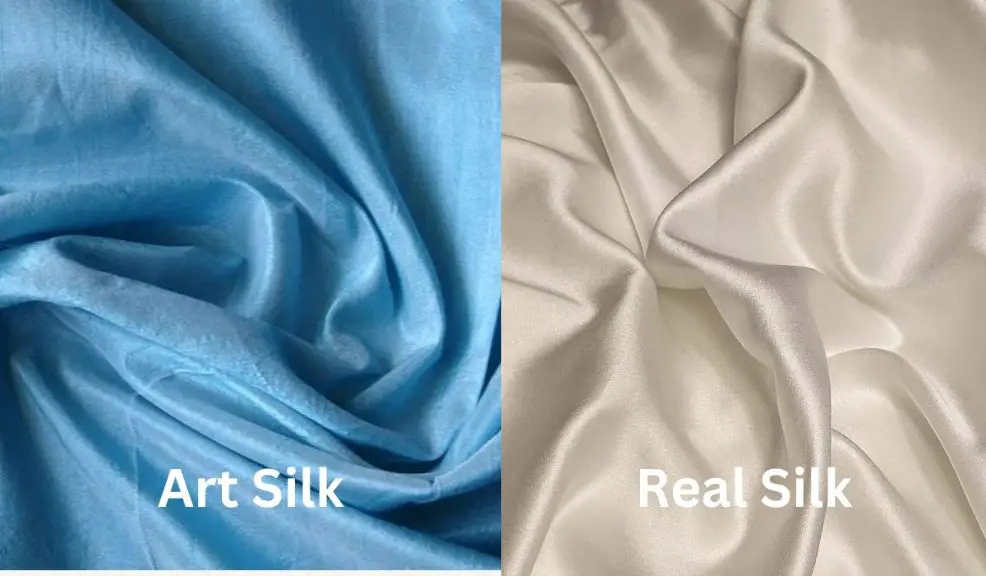
| Feature | Art Silk | Real Silk |
|---|---|---|
| Source | Man-made (rayon, polyester, nylon) | Natural protein fiber from silkworm cocoons |
| Price | Much cheaper (60-80% less) | Expensive due to labor-intensive production |
| Appearance | Can look very similar, sometimes with artificial gloss | Natural, subtle sheen with depth |
| Feel | Smooth and soft, but can feel slightly synthetic | Exceptionally smooth with a cool, fresh touch |
| Drape | Good drape, often more flowing than real silk | Beautiful drape with natural weight |
| Durability | Generally more durable, especially polyester types | Strong when dry, but weaker when wet |
| Care | Easier to care for, many are machine washable | Delicate, often requires dry cleaning or careful hand washing |
| Breathability | Varies (rayon breathes well, polyester doesn’t) | Excellent breathability and temperature regulation |
| Moisture Management | Rayon absorbs well, polyester doesn’t | Excellent moisture absorption and wicking |
| Wrinkle Resistance | Polyester types resist wrinkles well | Wrinkles easily |
| Lifespan | Good lifespan with proper care | Can last decades with excellent care |
| Environmental Impact | Mixed (rayon is biodegradable but chemical-intensive, polyester isn’t biodegradable) | Natural and biodegradable, but water and energy intensive |
| Ethical Concerns | Vegan-friendly, no animal products | Silkworms are killed in conventional silk production |
Art Silk vs Other Fabrics
Art Silk vs Rayon
Here’s where it gets a bit confusing: art silk and rayon are often the same thing! Rayon is the most common fiber used to make art silk. However, not all rayon is marketed as “art silk” – sometimes it’s just called rayon or viscose.

Art Silk vs Polyester
While polyester can be used to make art silk, regular polyester fabric doesn’t try to mimic silk. Art silk polyester is specifically woven and finished to look like silk, while regular polyester is used for everything from fleece to sportswear.
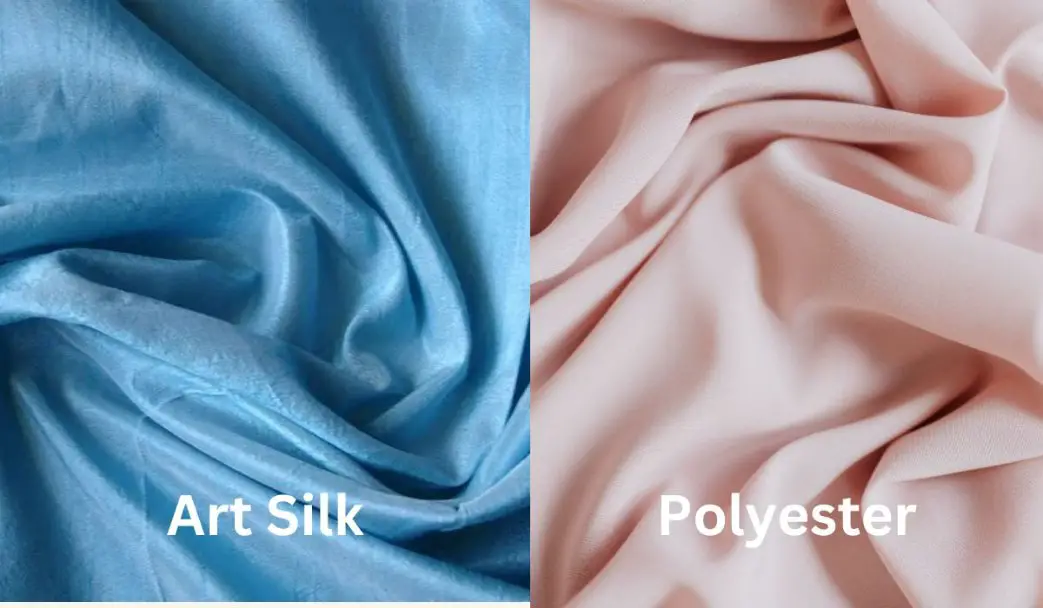
| Aspect | Art Silk (Rayon-based) | Art Silk (Polyester-based) | Regular Polyester |
|---|---|---|---|
| Softness | Very soft and silky | Smooth but less natural feel | Can feel synthetic and stiff |
| Breathability | Good breathability | Poor breathability | Poor breathability |
| Durability | Moderate (weakens when wet) | Very durable | Very durable |
| Wrinkle Resistance | Wrinkles easily | Highly wrinkle-resistant | Highly wrinkle-resistant |
| Cost | Moderate | Low to moderate | Very affordable |
| Biodegradable | Yes | No (200+ years) | No (200+ years) |
Art Silk vs Cotton
Some people wonder whether to choose cotton or art silk. These are very different fabrics with different uses.

Cotton is more breathable, natural, and great for everyday wear. It’s absorbent and comfortable in hot weather but doesn’t have that luxurious sheen.
Art silk gives you a dressier, more elegant look with its shiny finish and flowing drape. It’s better for special occasions or when you want something that looks more expensive.
For many people, the choice isn’t either/or – you want both in your wardrobe for different purposes!
Properties and Characteristics
Let’s talk about what makes art silk behave the way it does. Understanding these properties will help you decide if it’s right for your needs.
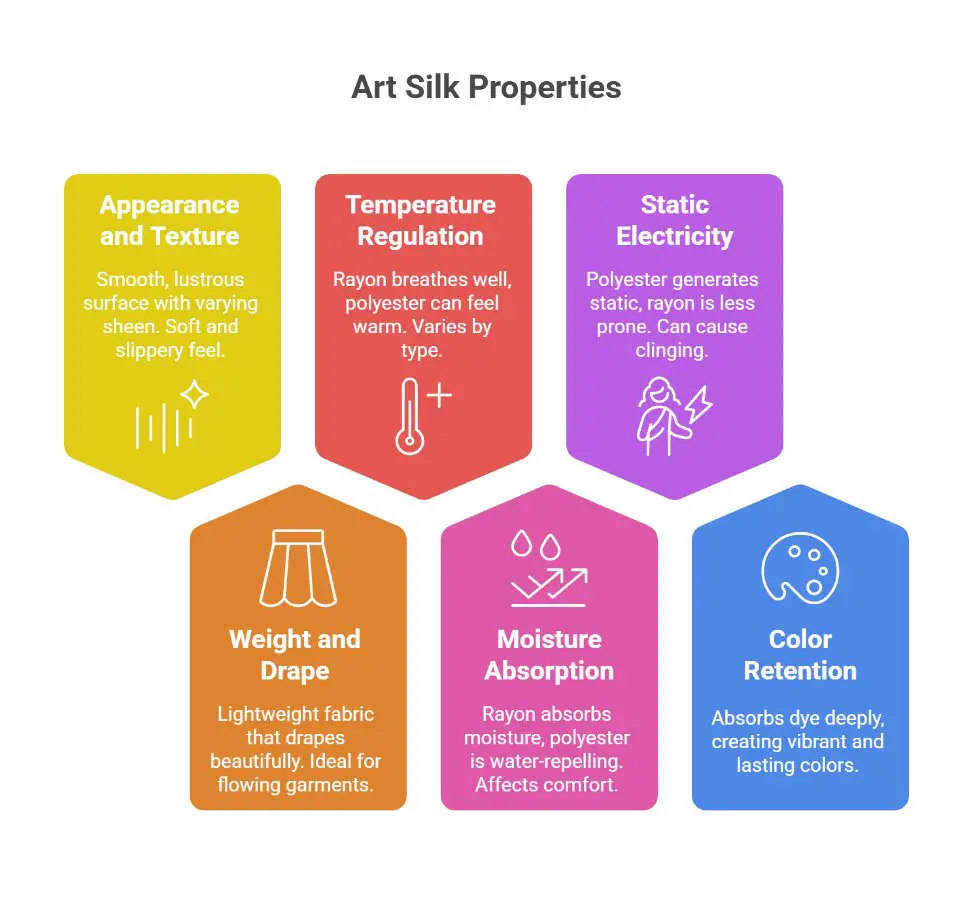
Appearance and Texture
Art silk has a smooth, lustrous surface that catches the light beautifully. The sheen can range from subtle (like rayon) to very glossy (like polyester satin). The fabric feels soft and slippery to the touch, though it may not have the same natural coolness as real silk.
Weight and Drape
Most art silk is lightweight and drapes beautifully, flowing over the body in soft folds. This makes it perfect for garments that need movement, like dresses and sarees. The weight is measured in GSM (grams per square meter) and typically ranges from 80-150 GSM for clothing.
Is Art Silk Heavy?
No, art silk is generally lightweight. It’s actually lighter than many natural silks, which is part of its appeal for clothing. The exact weight depends on the type and weave, but most art silk feels airy and comfortable to wear.
Temperature Regulation
This is where different types of art silk vary a lot. Rayon-based art silk breathes well and helps regulate body temperature, making it comfortable in various climates. Polyester-based art silk doesn’t breathe as well and can feel warm or clammy in hot weather.
Is Art Silk Good for Summer?
It depends on the type! Rayon-based art silk is excellent for summer because it’s breathable, lightweight, and doesn’t stick to your skin in humid weather. Many people find it more comfortable than real silk in hot climates because it’s less clingy.
Polyester art silk isn’t as good for summer because it doesn’t breathe well. However, it’s still lighter and more comfortable than heavy fabrics.
Moisture Absorption
Rayon art silk absorbs moisture well, similar to natural fibers. This helps wick sweat away from your skin. Polyester, on the other hand, is hydrophobic (water-repelling), which means it dries quickly but can feel less comfortable next to your skin.
Is Art Silk Comfortable to Wear?
Yes, most people find art silk comfortable, especially rayon-based varieties. The fabric is soft, lightweight, and doesn’t restrict movement. However, comfort also depends on fit, climate, and personal preference. Some people with sensitive skin prefer natural fibers, while others have no issues with art silk.
Static Electricity
Polyester art silk can generate static electricity, especially in dry winter months. This can make the fabric cling to your body or attract lint. Rayon is less prone to static.
Color Retention
One of art silk’s best features is how well it takes dye. Rayon especially absorbs dye deeply, creating rich, vibrant colors that stay bright through many washes. This is why you’ll see art silk in such bold, beautiful hues.
Sustainability and Environmental Impact
Whether art silk is good or bad for the environment isn’t a simple yes or no answer. It really depends on what type you’re talking about and how it compares to alternatives.

Is Art Silk Eco-Friendly?
Environmental Pros
- Vegan and Cruelty-Free: No silkworms are killed, unlike in traditional silk production where thousands die per kilogram of silk
- Rayon is Biodegradable: Unlike polyester, rayon will break down naturally in landfills within a few years
- Less Water-Intensive Than Real Silk: Art silk production uses less water than raising silkworms and growing mulberry trees
- More Accessible: Lower cost means less waste from buying expensive items you rarely wear
- Modern Eco Options: Tencel and Modal use closed-loop systems that recycle 99% of chemicals
Environmental Cons
- Chemical Processing: Traditional rayon production uses toxic chemicals like carbon disulfide that can harm workers and pollute waterways
- Polyester Isn’t Biodegradable: Polyester-based art silk takes 200+ years to break down and sheds microplastics when washed
- Energy Intensive: Both rayon and polyester production require significant energy, often from fossil fuels
- Deforestation Risk: Rayon production can contribute to deforestation if wood pulp isn’t sourced responsibly
- Water Pollution: Chemical runoff from production can contaminate local water sources if not properly treated
Comparing to Natural Silk
Interestingly, natural silk isn’t always more sustainable than art silk. Real silk production requires large amounts of water, land for mulberry trees, and energy to maintain controlled temperatures for silkworms. According to the Higg Materials Sustainability Index, silk ranks as one of the most environmentally damaging fabrics overall.
Art silk (particularly rayon) can actually have a lower environmental impact than real silk when you factor in the full lifecycle – though this depends heavily on production methods.
Making Better Choices
If sustainability matters to you, look for:
- Tencel or Lyocell: These use a closed-loop process with non-toxic solvents
- Modal: Made from beech trees with more sustainable processing
- FSC-Certified Rayon: Wood pulp from responsibly managed forests
- Recycled Polyester: Made from recycled plastic bottles, reducing new petroleum use
- OEKO-TEX Certified: Free from harmful chemicals. Learn more about OEKO-TEX certification standards
For a deeper look at silk sustainability and ethical considerations, check out this comprehensive guide from Good On You.
Uses and Applications
Art silk is incredibly versatile. Here’s where you’ll commonly find it:

Fashion and Clothing
- Sarees: Extremely popular in India for Banarasi, Kanjivaram, and Mysore style sarees
- Dresses: Everything from casual sundresses to formal evening gowns
- Blouses and Tops: Dressy tops with a professional or elegant look
- Scarves and Shawls: Lightweight wraps with beautiful drape
- Skirts: Flowing, feminine styles that move beautifully
- Lining Material: Used inside jackets and coats for smooth comfort
- Ties and Bow Ties: Men’s formal accessories
- Lingerie: Nightgowns, robes, and undergarments
Home Decor
- Curtains and Drapes: Elegant window treatments with beautiful light diffusion
- Cushion Covers: Add a touch of luxury to sofas and beds
- Bedding: Sheets, pillowcases, and duvet covers (though less common than for clothing)
- Table Linens: Tablecloths and runners for special occasions
- Upholstery: Furniture covering for decorative pieces
Special Occasions
Art silk really shines for events where you want to look dressed up without spending a fortune:
- Weddings (as a guest or for bridesmaids)
- Festivals and religious celebrations
- Formal parties and galas
- Office events and presentations
- Date nights and special dinners
Historical and Industrial Uses
Historically, art silk (particularly nylon) was used for parachutes during World War II. It’s also been used for umbrellas, bags, and other items where a silk-like appearance is desired with more durability.
Complete Care Guide for Art Silk
One of the best things about art silk is that it’s much easier to care for than real silk. However, you still need to treat it gently to keep it looking great. Here’s everything you need to know.
Can You Wash Art Silk?
Yes! Unlike real silk, which often requires dry cleaning, most art silk can be washed at home. The exact method depends on whether it’s rayon or polyester-based.
Before You Wash: Check the Care Label
Always read the care label first. Some art silk items have special finishes or embellishments that require professional cleaning. The label will tell you exactly what the manufacturer recommends for that specific garment.
Hand Washing Art Silk (Best Method)
Step-by-Step Hand Washing:
- Test for Color Bleeding: Wet a small hidden area (like inside a seam) with cold water and press with a white cloth. If color transfers, take it to a dry cleaner instead
- Fill a Basin: Use cool or lukewarm water (never hot – keep it under 30°C/86°F)
- Add Detergent: Use a mild detergent designed for delicates. About 1 teaspoon per gallon of water is enough. Avoid harsh detergents with bleach or enzymes
- Submerge the Fabric: Gently place your art silk item in the water and swish it around gently. Don’t scrub or wring!
- Soak Briefly: Let it soak for 3-5 minutes, no longer
- Rinse Thoroughly: Drain the soapy water and refill with clean, cool water. Rinse until all soap is gone (this usually takes 2-3 rinses)
- Optional Vinegar Rinse: Add ¼ cup white vinegar to the final rinse to remove soap residue and restore softness
- Remove Excess Water: Gently press (don’t wring!) the water out. You can also roll the item in a clean towel and press to absorb moisture
You can use our Fabric Care Calculator to get personalized washing instructions based on your specific art silk item.
Machine Washing Art Silk
Many art silk items can be machine washed, but you need to be careful:
Safe Machine Washing Tips:
- Use a Mesh Bag: This protects the fabric from tangling and catching on other items or the drum
- Select Delicate/Gentle Cycle: Choose the gentlest cycle your machine has
- Cold Water Only: Never use warm or hot water
- Mild Detergent: Use a detergent formulated for delicates or silk
- Shortest Spin Cycle: Reduce agitation as much as possible
- Don’t Overload: Wash art silk separately or with other delicates only – never with jeans or heavy items
Drying Art Silk
Never use a tumble dryer! The heat can shrink, damage, or melt art silk (especially polyester types).
Proper Drying Method:
- Lay Flat or Hang: Most items should be laid flat on a clean towel to dry. Alternatively, hang on a padded hanger for items like dresses
- Avoid Direct Sunlight: UV rays can fade colors and weaken fibers. Dry in a shaded, well-ventilated area
- Reshape While Damp: Gently pull the item into its proper shape while it’s still slightly damp
- Air Dry Completely: Make sure it’s 100% dry before storing to prevent mildew
Does Art Silk Shrink?
Art silk can shrink, especially rayon types, if washed in hot water or put in the dryer. Shrinkage is usually 3-5% for rayon and less for polyester. This is why it’s so important to use cold water and air dry only.
If you’re sewing with art silk fabric, always pre-wash it before cutting to account for any shrinkage.
Ironing and Steaming
Art silk wrinkles more easily than polyester but less than real silk.
How to Iron Art Silk:
- Check if Ironing is Needed: Sometimes hanging in a steamy bathroom is enough
- Turn Inside Out: Always iron on the wrong side to protect the sheen
- Low Heat Setting: Use the “silk” or lowest setting on your iron
- Use a Pressing Cloth: Place a thin cotton cloth between the iron and the fabric
- Iron While Slightly Damp: For best results, iron when the fabric is still a tiny bit damp from washing
- Don’t Press Too Hard: Let the iron glide gently – don’t push down
- Never Use Steam on Polyester Art Silk: It can cause water spots
Steaming is actually better for art silk than ironing. A handheld steamer held about an inch away from the fabric works great and is much safer.
Stain Removal
Act Fast: Fresh stains are much easier to remove than set-in ones. Blot (never rub!) stains immediately with a clean, white cloth.
For different types of stains:
- Water-Based Stains (coffee, wine, juice): Blot with cool water, then treat with a tiny amount of mild soap
- Oil-Based Stains (makeup, grease): Sprinkle with cornstarch or talcum powder to absorb the oil, let sit for 30 minutes, then gently brush off and wash
- Ink: Dab with rubbing alcohol on a cotton swab (test on hidden area first!)
- Perspiration: Soak in cool water with a tablespoon of white vinegar, then wash normally
Never use bleach or harsh stain removers on art silk – they can permanently damage or discolor the fabric.
Storage Tips
- Clean Before Storing: Never put away dirty art silk – stains and body oils can set and attract pests
- Use Breathable Garment Bags: Cotton or fabric bags are better than plastic, which can trap moisture
- Hang or Fold: Heavy items like sarees should be folded, while dresses can be hung on padded hangers
- Cool, Dark, Dry Place: Avoid damp basements or hot attics
- Use Cedar or Lavender: Natural moth repellents are safer than chemical mothballs
- Avoid Wire Hangers: They can leave marks and rust stains
Does Water Damage Art Silk?
Water itself doesn’t damage art silk the way it can damage real silk, but it can cause problems if not handled correctly. Rayon weakens when wet and can stretch or tear if pulled. Water spots can also appear on polyester art silk if it’s not dried properly.
The key is to handle wet art silk very gently and dry it properly to avoid issues.
Can You Use Vinegar to Clean Art Silk?
Yes! White vinegar is actually great for art silk. A vinegar rinse (¼ cup in the final rinse water) helps remove soap residue, restore softness, and can even help prevent color fading. Just make sure to dilute it well and use it as a rinse, not as the main cleaning agent.
For more detailed care instructions, check out our Silk Care Guide.
Quality Assessment Guide
Not all art silk is created equal. Here’s how to spot the difference between high-quality and low-quality art silk.
How to Identify Art Silk
First, let’s talk about how to tell art silk from real silk. This matters because some sellers try to pass off art silk as real silk at silk prices.
Visual Tests:
- Sheen: Real silk has a natural, subtle sheen that changes in different lights. Art silk (especially polyester) often has a more uniform, sometimes artificial-looking gloss
- Weave: Look closely at the weave. Real silk has slight irregularities because it’s made from natural fibers. Art silk is often too perfect and uniform
- Drape: Real silk has a specific weight and falls in a certain way. Art silk can drape well but might flow differently – often more freely
Touch Tests:
- Temperature: Real silk feels cool and fresh to the touch. Art silk (especially polyester) may feel slightly warmer or more neutral
- Texture: Real silk has a crisp, dry feel even though it’s smooth. Art silk can feel slippery or have a slightly synthetic texture
- Scrunch Test: Scrunch the fabric in your hand. Real silk makes a distinctive crunching sound. Art silk is usually quieter
The Burn Test (Most Reliable):
Warning: Only do this test on a small thread from a hidden seam or hem. Never test on the main fabric unless you’re sure you won’t buy/use it!
- Real Silk: Burns slowly with a smell like burning hair or feathers. Forms a crushable black ash
- Rayon Art Silk: Burns quickly with a burning paper smell. Leaves little ash
- Polyester Art Silk: Melts and forms hard black beads. Smells like burning plastic
Check the Label:
By law, fabric content must be listed accurately. Look for these terms:
- “100% Silk” or “Pure Silk” = Real silk
- “Art Silk,” “Artificial Silk,” “Rayon,” “Viscose,” “Polyester” = Art silk
- “Silk Blend” = Usually part real silk, part synthetic (check the percentages)
Judging Art Silk Quality
Once you know it’s art silk, here’s how to tell if it’s good quality:
What to Look For:
- Fiber Content: Higher quality usually means rayon or rayon-silk blends. Pure polyester art silk is cheaper but less comfortable
- GSM (Weight): Check the grams per square meter. For clothing, 100-130 GSM is good quality. Too light (under 80 GSM) will be flimsy and see-through
- Weave Quality: Look for tight, even weaving without loose threads or gaps
- Color Consistency: The color should be even throughout with no streaks or patches
- Finish: Feel the fabric – it should be smooth and consistent, not scratchy or rough in places
- Selvage: The edges should be neatly finished, not fraying excessively
Red Flags:
- Very cheap price (if it seems too good to be true, it probably is)
- No care label or fiber content listed
- Uneven color or texture
- Chemical smell that doesn’t go away after airing
- Excessive shedding or pilling right away
- Seller claims it’s “real silk” but price is too low
Buying Guide
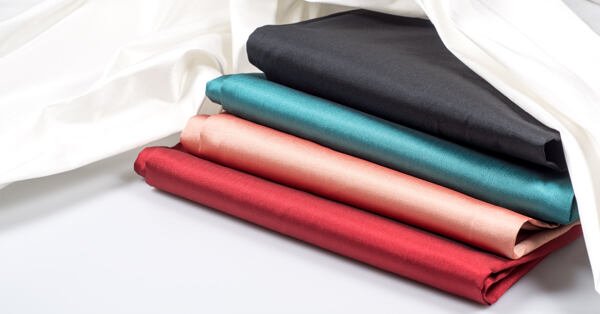
Is Art Silk Expensive?
No, art silk is much more affordable than real silk – that’s one of its main advantages! Here’s what to expect price-wise:
| Item Type | Art Silk Price Range | Real Silk Price Range |
|---|---|---|
| Saree | $20-$100 | $100-$1,000+ |
| Dress | $30-$150 | $150-$500+ |
| Scarf | $10-$40 | $50-$200+ |
| Fabric (per yard) | $5-$20 | $25-$100+ |
| Bedding Set | $50-$200 | $300-$1,500+ |
Where to Buy
- Online Marketplaces: Amazon, eBay, and Etsy have huge selections but quality varies widely
- Specialty Fabric Stores: Better quality control and expert advice
- Indian Clothing Stores: Great for art silk sarees and traditional wear
- Department Stores: Mid-range quality at reasonable prices
- Direct from Manufacturers: Often the best prices for bulk purchases
What to Ask/Check:
- Exact fiber content (rayon, polyester, or blend?)
- GSM or weight specification
- Country of origin and manufacturing standards
- Care instructions
- Return policy (important since online photos can be misleading)
- Customer reviews focusing on quality and durability
Regional Variations and Styles
Art silk has been adapted to create affordable versions of regional silk styles, particularly in India where silk sarees are an important part of culture.
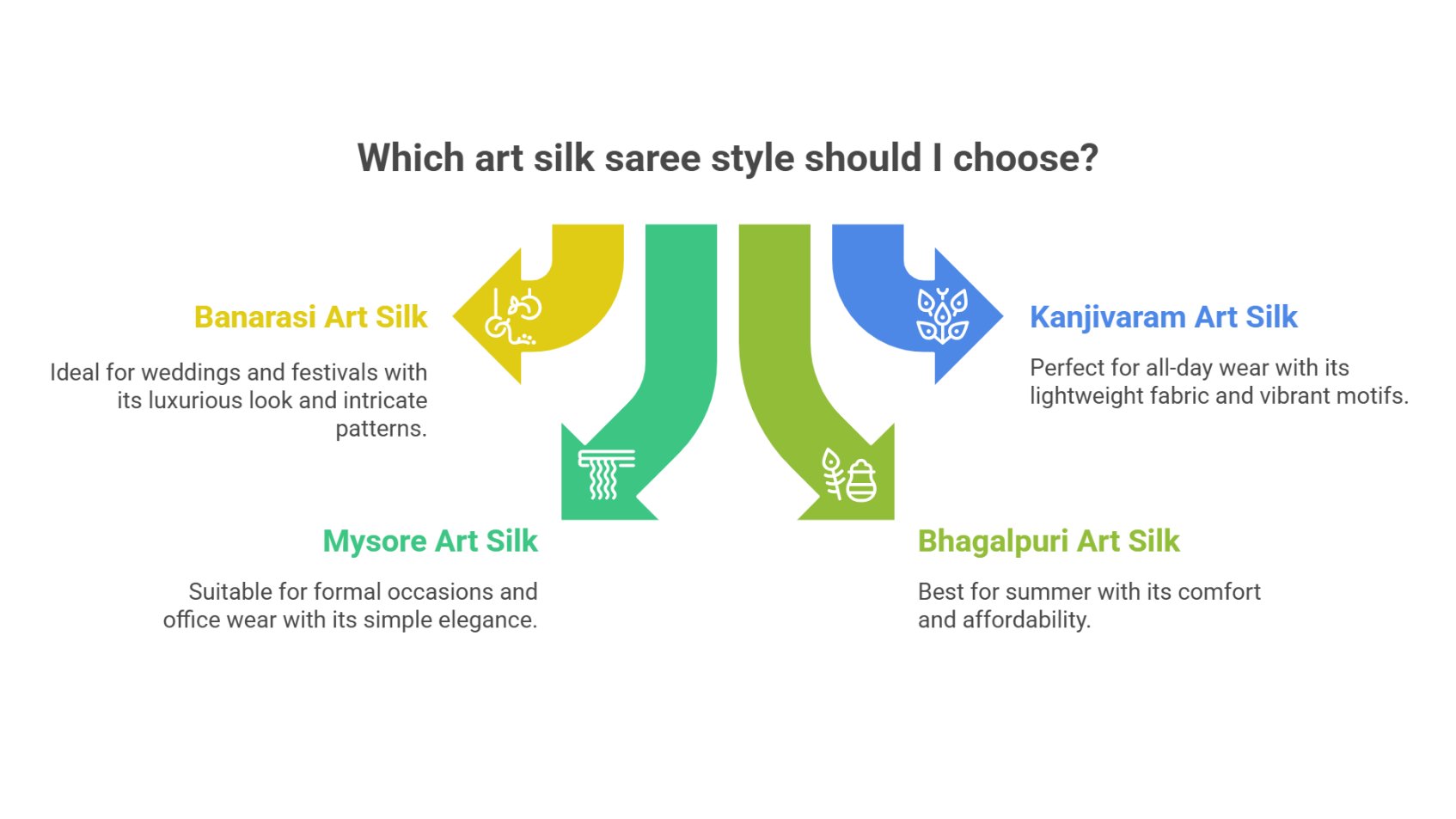
Banarasi Art Silk
Inspired by the traditional silk sarees from Varanasi (Banaras), these feature intricate patterns influenced by Mughal and Persian art. You’ll see lots of gold and silver zari work (metallic thread embroidery), brocade patterns, and heavy borders. Banarasi art silk sarees are popular for weddings and festivals because they look expensive but cost much less than real Banarasi silk.
Which is Better: Banarasi Silk or Kanjivaram Silk?
This depends on what you’re looking for! Both are beautiful in their own ways:
Banarasi silk (and art silk) is known for its Persian-inspired patterns, heavy zari work, and slightly lighter weight. It’s popular in North India.
Kanjivaram silk (and art silk) features bold temple borders, traditional South Indian motifs like peacocks and temples, and is typically heavier and more durable. It’s the traditional choice in Tamil Nadu and South India.
For art silk versions, both are great budget-friendly options that let you get the traditional look without the traditional price!
Kanjivaram Art Silk
These mimic the famous silk sarees from Kanchipuram in Tamil Nadu. They feature contrasting borders, temple and peacock motifs, and vibrant color combinations. The art silk version is much lighter than traditional Kanjivaram silk, making it more comfortable for all-day wear.
Mysore Art Silk
Known for simple elegance, Mysore art silk has a soft, smooth texture and typically features subtle designs. It’s great for both formal occasions and everyday office wear.
Bhagalpuri Art Silk
Lightweight and perfect for summer, Bhagalpuri art silk is popular for its comfort and affordability. It often features block prints and natural motifs.
Future of Art Silk: Innovations and Alternatives
The textile industry is constantly developing new alternatives to both natural silk and traditional art silk. Here are some exciting innovations to watch:

Spider Silk (Microsilk™)
Companies like Bolt Threads have created spider silk proteins through fermentation – they use yeast, sugar, and water instead of actual spiders! The result is a biodegradable fabric that’s incredibly strong. While still in limited production, this could be the future of sustainable luxury fabrics.
Orange Fiber
Made from orange peel waste from the juice industry, this fabric has already been used by major fashion houses like Salvatore Ferragamo. It’s soft, sustainable, and gives new life to what would otherwise be trash.
Rose Petal and Banana Fiber Silk
These plant-based alternatives are still developing but show promise for creating silk-like fabrics from agricultural waste products.
Improved Tencel and Modal
These eco-friendly rayons are becoming more widely available and affordable. They use sustainable wood sources and closed-loop production systems that recycle chemicals.
Recycled Polyester Art Silk
Made from recycled plastic bottles and other post-consumer waste, this gives polyester art silk a better environmental story.
Frequently Asked Questions
Art silk is neither inherently good nor bad – it depends on your priorities. It’s excellent if you want the look of silk at an affordable price, prefer vegan materials, or need something easier to care for than real silk. However, it’s not as breathable or luxurious as natural silk, and polyester versions aren’t environmentally friendly. For most people, art silk is a smart choice for everyday elegant wear, while real silk might be reserved for truly special pieces.
No, “soft silk” usually refers to natural silk with a particularly smooth finish, while art silk is a synthetic alternative. However, some sellers use “soft silk” as a marketing term for rayon or other art silks, which can be confusing. Always check the fiber content label to know exactly what you’re getting.
Often, yes! Viscose and rayon are the same thing, and they’re the most common materials used to make art silk. However, art silk can also be made from polyester, nylon, or blends. If a label says “art silk,” check the fiber content to see if it’s viscose/rayon or another material.
Rayon (also called viscose) is the fiber most commonly referred to as art silk. It was originally developed in the 1890s specifically as an artificial silk. While polyester and nylon can also be made into silk-like fabrics, rayon has the strongest historical association with the term “art silk.”
Silk blends (which contain some real silk mixed with synthetic fibers) are generally higher quality than pure art silk. They combine the best properties of both – some of the natural breathability and luxury of real silk with the durability and affordability of synthetics. However, they’re also more expensive than pure art silk. Choose based on your budget and how much the benefits of real silk matter to you.
Cotton silk blends are better if you prioritize natural fibers, breathability, and comfort for hot weather. Art silk is better if you want maximum shine, drape, and that classic silk look. Cotton silk is also generally easier to care for and more durable. The best choice depends on your climate, intended use, and personal values regarding natural vs synthetic materials.
Art silk can cling to the body, especially in humid conditions or if it’s cut in a fitted style. However, it’s generally less clingy than real silk. The amount of cling depends on the specific type (rayon tends to drape away from the body, while polyester can be more static and clingy) and the garment construction. Wearing a slip or choosing looser cuts can help if you prefer less body-hugging styles.
Art silk is generally safe for skin, though real silk has more natural benefits. Rayon-based art silk is soft and non-irritating for most people. However, polyester art silk can sometimes cause issues for people with sensitive skin or in hot, sweaty conditions. If you have skin sensitivities, choose rayon or modal art silk over polyester, and look for OEKO-TEX certified fabrics that are tested for harmful chemicals. Real silk has natural antibacterial properties that art silk doesn’t have.
Real silk has some health advantages over cotton: it’s naturally hypoallergenic, contains proteins that are gentle on skin and hair, stays cleaner longer due to antibacterial properties, and causes less friction (good for preventing wrinkles and hair breakage). However, cotton is more breathable and absorbent, making it better for hot weather and people who sweat a lot. Art silk doesn’t have these same health benefits as real silk. For more on fabric comparisons, visit our guide on what to know about silk fabric.
Yes, artificial silk (especially rayon types) can shrink by 3-5% if washed in hot water or put in the dryer. Polyester art silk shrinks less but can still be damaged by high heat. Always wash in cold water and air dry to prevent shrinkage. If you’re sewing with art silk fabric, pre-wash it before cutting your pattern pieces.
“Artistic silk” is just another name for art silk or artificial silk – there’s no difference. Some sellers use this term to make it sound more appealing, but it refers to the same synthetic silk alternatives made from rayon, polyester, or other man-made fibers.
Conclusion
After covering everything from manufacturing to care instructions, let’s wrap up with some clear takeaways to help you decide if art silk fits your needs.
Key Takeaways
Art silk excels when you want:
- The look and feel of silk without the high price
- Vegan, cruelty-free alternatives to animal-based fabrics
- Something easier to care for than real silk
- Vibrant colors and a variety of prints
- More durability for everyday wear
- Beautiful drape and shine for special occasions
Consider real silk or other options if:
- You need the best breathability and temperature regulation
- You have the budget for luxury natural fibers
- You want something that will last generations with proper care
- Natural antibacterial and hypoallergenic properties matter to you
- You’re buying a once-in-a-lifetime piece like a wedding dress
Smart Shopping Recommendations
1. Choose the right type for your needs: Rayon-based art silk for breathability and comfort, polyester for durability and wrinkle resistance, or blends for a balance of both.
2. Don’t compromise on quality: A well-made art silk piece will serve you better than cheap real silk. Look for good GSM weight, tight weaving, and clear care labels.
3. Consider the occasion: Art silk is perfect for regular special occasions, while you might want to invest in real silk for heirloom pieces.
4. Check environmental credentials: If sustainability matters, choose Tencel, Modal, or recycled polyester art silks with proper certifications.
5. Learn proper care: Even budget-friendly art silk will last longer and look better with the right care. Cold water washing and air drying are your best friends.
Building a Versatile Wardrobe
You don’t have to choose between art silk and other fabrics – the smartest approach is having a mix. Here’s what we recommend:
- Everyday basics: Cotton for comfort and breathability
- Special occasions: Art silk for affordable elegance
- Investment pieces: Real silk or high-quality natural fibers
- Practical items: Polyester blends for easy care
- Traditional wear: Regional art silk styles that honor cultural heritage
Final Thoughts
Art silk has come a long way since its invention in the 1890s. Modern production methods have created fabrics that are beautiful, affordable, and accessible to everyone. While it may not have all the properties of natural silk, it fills an important role in making elegant, silk-like clothing available at reasonable prices.
Whether you’re shopping for a special saree, a dressy blouse for work, or elegant curtains for your home, art silk offers an excellent option that won’t break your budget. Just remember to check the fiber content, assess the quality, and follow proper care instructions to get the most out of your art silk items.
The key is knowing what you’re buying, understanding its properties, and setting realistic expectations. Art silk isn’t trying to be real silk – it’s its own fabric with its own advantages. When you approach it that way, you’ll find it’s a valuable addition to your wardrobe and home.
Ready to Start Your Art Silk Journey?
Now that you know everything about art silk, you can make informed decisions about when to choose it, how to care for it, and how to get the best value for your money. Happy shopping, and enjoy the beauty of art silk!

